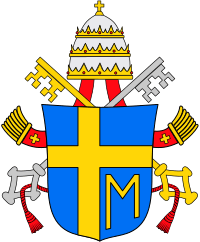Funeral of Pope John Paul II
The funeral of Pope John Paul II was held on 8 April 2005, six days after his death on 2 April. The funeral was followed by the novemdiales devotional in which the Catholic Church observes nine days of mourning.[1]
The body of Pope John Paul II lying in state | |
| Date | 8 April 2005 |
|---|---|
| Location | St. Peter's Basilica, Vatican City |
| Participants | The College of Cardinals (led by then-Cardinal Joseph Ratzinger), various dignitaries worldwide, worldwide Catholics |
On 22 February 1996, Pope John Paul II introduced revisions to the centuries-old ceremonies surrounding papal death, repose and burial. The revisions enacted through the apostolic constitution Universi Dominici gregis applied to his own funeral.[2]
Pope John Paul's funeral brought together what was, at the time, the single largest gathering in history of heads of state outside the United Nations,[3] surpassing the 1965 funeral of Winston Churchill, only to be surpassed by the 2012 Summer Olympics opening ceremony and the funeral of former South Africa leader Nelson Mandela in December 2013. Four kings, five queens, at least seventy presidents and prime ministers, and more than fourteen leaders of other religions attended, alongside the faithful.[4] It is likely to have been one of the largest single gatherings of Christianity in history, with numbers estimated in excess of four million mourners gathering in Rome alone.[5][6][7]
Coinciding with the funeral in Vatican City, bishops at cathedrals throughout the world celebrated memorial masses. In an historical rarity, Protestant and Eastern Orthodox leaders, as well as representatives and heads from Judaism, Islam and Buddhism, offered their own memorials and prayers as a way of sympathising with the grief of Catholics.
At the funeral itself, Ecumenical Patriarch Bartholomew I of the Eastern Orthodox Church was in the honorary first seat in the sector reserved for delegations from churches not in full communion with the See of Rome; this was the first time an Ecumenical Patriarch attended a papal funeral since the East–West Schism.[8] The Archbishop of Canterbury (then Rowan Williams), was also present at the papal funeral, the first time since the Church of England broke with the Catholic Church in the 16th century. Also for the first time ever, the head of the Ethiopian Orthodox Tewahedo Church, Patriarch Abune Paulos, attended a papal funeral.
Rite of Papal Death
Centuries of sacred rituals are set in motion upon the death of a Pope, and these are administered by the Cardinal Camerlengo.
When John Paul II died, the Camerlengo Eduardo Martínez Somalo removed the Pope's Ring of the Fisherman from his finger, then ceremonially crushed it with the ceremonial silver hammer in the presence of members of the College of Cardinals.[9] This was originally done to prevent the creation of forged, backdated documents, which would appear to have been approved by the late pope.
After the ring's destruction, Cardinal Martínez Somalo cordoned off and placed wax seals on the entrances to the Pope's private bedroom and study. This tradition originates from ruthless cardinals looting the papal chambers upon the death of past popes.
The Pope's formal death certificate was signed by the physician Renato Buzzonetti, Director of the Department of Health and Sanitation of Vatican City, on the evening of his death. Cardinal Martínez Somalo then ceremonially ordered the Dean of the College of Cardinals, Cardinal Joseph Ratzinger, to summon the cardinals of the world to Vatican City to elect a new pope.
While his predecessors had been embalmed after death, the Vatican claimed that Pope John Paul II was not embalmed and lay in state without normal treatment for preservation, which is evident by the grey colour taken on by the body. Also, it was customary for popes to have their organs removed after death. Pope Pius X ended this practice during his reign, and the wish of some Poles that John Paul II's heart be buried in Poland was not obliged.[1]
Exposition and Lying in State

John Paul II's body was clothed in the familiar white soutane, over which was placed a plain white alb. A stole, the symbol of ordained ministry, was placed around his neck. Over the inner vestments, John Paul II was clothed in a red chasuble. An ancient Byzantine custom, red is the colour of mourning for Popes. Around his collar, the pallium of white lamb's wool was draped. A white zucchetto and a white bishop's mitre adorned John Paul II's head. In his arm rested Paul VI's pastoral cross-staff, used by popes in place of the crozier. His hands clasped a rosary. At first, he lay in state in his favourite pair of Polish-made brown leather shoes, size 44-1/2, which he wore on his travels throughout the world. Later, following the example of his immediate predecessors, these were changed to plain red leather papal shoes.
The body of John Paul II was exposed first in the Papal Residence and venerated by the Clergy before a procession, after which it was placed in St. Peter's Basilica; The Swiss Guard remained always beside the body while it was exposed for viewing. After the placement of the body before the Burial Site of St. Peter, the faithful who had gathered in St. Peter's Square were allowed to enter the Basilica to pray before the exposed body. It remained there before a private ceremony of the placement of the body in a cypress casket, and then was brought outside into the Square for the funeral. For the funeral, the Swiss Guard departed the body to guard the Requiem Mass, presided by then-Cardinal Joseph Ratzinger.
Mass of Repose
A first Mass of Repose, such as is offered for anyone baptised in the Catholic Church, commemorating the sending of the soul to God, was led by Cardinal Angelo Sodano, Cardinal Secretary of State, on 3 April 2005, the day after the death of the Pope. That Sunday service coincided with the celebration of the Feast of Divine Mercy, a memorial feast instituted by Pope John Paul II himself.[10] The service was followed by the recitation of the Regina Caeli, at which Archbishop Leonardo Sandri, Substitute of the Secretariat of State read out the words that John Paul II himself wrote for the occasion and was due to recite.[11]
Rite of Visitation
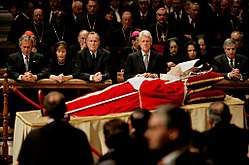
The body of John Paul II was dressed in his vestments and moved to the Clementine Hall on the third level (considered the second floor) of the Apostolic Palace on 3 April.[1] His body was laid on a sloped olive-sheeted catafalque and his head propped on a stack of three gold pillows. Near the catafalque was a wooden crucifix and a paschal candle symbolic of Jesus Christ as the light of the world in the face of darkness and death. His body was guarded by the Swiss Guard, a corps of men which has sworn to protect the pope through several centuries. During a period of private visitation Vatican officials and a contingent of officials from the Italian government viewed the body of John Paul II.
On 4 April, the body of John Paul II was moved onto a red velvet catafalque, with his head propped on three red pillows. The Papal Gentlemen, clothed in black morning coats and white gloves, were chosen as pallbearers and stood along the sides of the pope's bier. Cardinal Martínez Somalo, dressed in red and gold vestments, officiated the asperges rite. He blessed the pope with the holy waters of baptism three times: to the right of the pope, at his head and then to his left. An acolyte then brought to the Camerlengo a thurible and boat. Cardinal Martínez Somalo incensed the pope three times.

A long procession was begun in order to transfer the body of John Paul II from the Clementine Hall, through the colonnades of the Apostolic Palace and into St. Peter's Square among the waiting people. Traditionally, the pope's body is then brought to either St. Peter's Basilica or the papal cathedral, St. John Lateran Basilica. A procession of monks, priests and bishops paced slowly along a route towards St. Peter's Basilica. The College of Cardinals trailed by Cardinal Joseph Ratzinger and Cardinal Martínez Somalo followed them.
As the ritual dating back to the medieval era proceeded, Gregorian chants were sung by several religious orders with the people responding to each verse with the ancient Greek prayer, "Lord, have mercy" or "Kyrie eleison." The Litany of the Saints was sung. After each name of a martyr or saint was chanted, invoking his or her intercession between God and the people, participants in the procession sang the Latin words, "Ora pro eo," meaning "Pray for him." This is a departure from the traditional, "Pray for us" or "Ora pro nobis."
When the body of the pope was hoisted upon the steps of St. Peter's Basilica, the Papal Gentlemen turned the bier and lifted the pope's head to face the tens of thousands of people that filled St. Peter's Square. Cardinal Martínez Somalo noted it as the pope's symbolic last look at the devoted followers that had filled St. Peter's Square throughout the papacy of John Paul II.
The procession ended with the seating of the College of Cardinals and the placement of the bier carrying the body of John Paul on a catafalque in front of the steps leading to the altar of St. Peter's Basilica. The paschal candle was lit and the body of the Pope was incensed again by Cardinal Martínez Somalo. Prayers were said and a reading from the Gospels was performed by a deacon. After the College of Cardinals paid their respects and left the sanctuary, the basilica was closed and then reopened for the official lying in state to last until the day of the Mass of Requiem and subsequent interment.
Requiem Mass
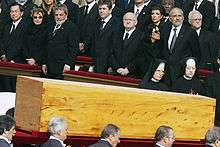
Cardinal Joseph Ratzinger celebrated the Mass of Requiem on 8 April at 10:00 am CEST (08:00 UTC), by virtue of his office as Dean of the College of Cardinals.[12] He was also one of Pope John Paul II's closest friends and carried out most of the Pope's duties during his final illness. Concelebrating in the Mass of Requiem were the College of Cardinals (the number of members that were present has been variously given as 157 and 164) and the patriarchs of the Eastern Catholic Churches.
As the pope must be buried between the fourth and sixth day after his death, Friday was chosen as the last possible date. The Mass at St. Peter's Basilica was the first Mass of Requiem for a pope to be televised live in almost every nation in the world.
The event had an estimated viewership of over 2 billion people; the Catholic Church claims only 1.3 billion among its members. The funeral of John Paul II was by far the largest funeral in the history of the world. In lieu of a public viewing at the Basilica of St. John Lateran, as was tradition, immense digital screens instead broadcast the Mass of Requiem and subsequent Rite of Interment to those in the pope's cathedral church outside the confines of Vatican City. The same digital screens were hoisted at several sites in Rome, including the Circus Maximus, and at specially designated campsites outside the city for the millions of pilgrims who descended on the city.[1]
The funeral was perhaps the most-watched live event in the history of television. Because people in North America understood that the service took place during the early morning hours on their side of the Atlantic, many awoke to view the funeral, and others taped it for a historical record. In addition, several television networks in the Americas rebroadcast the funeral later in the day.
Processional

As the Mass of Requiem began, the doors of St. Peter's Basilica were locked with dignitaries asked to stand outside the church. Only the College of Cardinals and the patriarchs and presiding metropolitans of the Eastern Catholic Churches were allowed inside for a private ceremony in which John Paul was placed in a cypress coffin, the first of three.[13] Before being laid in the coffin, Archbishops Marini and Stanisław Dziwisz had the honour of placing a white silk veil over the face of the pope (a tradition started by Leo XIII). It was his last official act of service to the pope as his papal secretary.[8] The body was lowered into a cypress coffin, which served as the innermost coffin. Along with the body was a sealed document, the Rogito, a eulogy detailing the life and works of John Paul II, read aloud in Latin by Archbishop Marini and signed by those present during the funeral. Three bags containing gold, silver, and copper euro coins were placed beside the body. Each bag contained one coin for each year in John Paul II's reign, constituting the only monetary compensation he ever received for his service as pope, which totalled to about €100. After the private ceremony, the doors of St. Peter's Basilica were opened while dignitaries were seated. Cardinal Ratzinger and his concelebrants prepared for their procession from inside the basilica to a marble apron in the middle of St. Peter's Square where the Mass of Requiem was held.
The procession began with the introductory chant, "Requiem Aeternam" ("Eternal Rest Grant Him, O Lord"), which includes verses from Psalm 64 (65), "To You We Owe Our Hymn of Praise, O God of Zion." Carried on the shoulders of the Papal Gentlemen, the coffin bearing the image of John Paul II's coat-of-arms burned onto the lid, the pope was carried into St. Peter's Square onto the marble apron. Archbishop Marini and Konrad Krajewski, Papal Master of Ceremonies led the coffin, carrying a red leather-bound Book of the Gospel. The Papal Gentlemen laid the coffin onto a red carpet directly front in the altar, with the Book of the Gospel placed open on top of it.
Liturgy of the Word
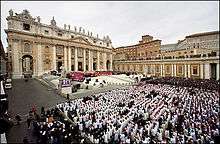
The Liturgy of the Word began with a reading from the Acts of the Apostles, 10:34–43, read by Chilean Alejandra Correa in Spanish. The responsorial was Psalm 22(23). The second reading was read by John McDonald in English, taken from the Letter of Saint Paul to the Philippians, 3:20–4:1. It was entitled, "But our citizenship is in heaven." The reader ended by singing, "Verbum Domini" ("The Word of the Lord.") Congregants replied in chant, "Deo gratias" ("Thanks be to God.")
Congregants stood for the proclamation of the Gospel, heralded by the singing of Alleluia. After being blessed by Cardinal Ratzinger, an English deacon of the Archdiocese of Birmingham, Paul Moss (who has now been ordained priest and is currently serving as Vocations Director for the Archdiocese of Birmingham), proceeded with the Book of the Gospels to the ambo or lectern. He began by singing, "The Gospel according to John." Congregants replied, "Glory to you, O Lord." Moss then incensed the Book of the Gospel and then sang the reading in Latin. The reading came from John chapter 6, verse 40, stating, "For this is the will of my father that everyone who sees the son and believes in him may have eternal life." Moss then read from John chapter 21, verses 15 through 19, which is an account of a dialogue between Jesus and Saint Peter. Jesus asked three times, "Do you love me?" He then told his disciple, "Follow me." The deacon raised the Book of the Gospel and sang, "Verbum Domini" or "The Gospel of the Lord." Congregants replied in chant, "Praise to you, Lord Jesus Christ."
Homily
After kissing the text of the Book of the Gospels, Cardinal Ratzinger stood before the congregants to offer the homily which included references to the life and service of Pope John Paul. He spoke in Italian, first greeting the many political figures and religious leaders that had gathered, and then told the story of how the young Karol had answered the Lord's call, and became a priest after the persecution of the Nazis, the answer of the command: "Follow me!" Cardinal Ratzinger also told of John Paul's life as a bishop, cardinal, and pope, frequently applying scripture to the pope's life. Finally, he told of the pope's devotion to Mary and the Divine Mercy of Christ. The cardinal's last words were about the end of Pope John Paul II's life:
- None of us can ever forget how in that last Easter Sunday of his life, the Holy Father, marked by suffering, came once more to the window of the Apostolic Palace and one last time gave his blessing Urbi et Orbi. We can be sure that our beloved pope is standing today at the window of the Father's house that he sees us and blesses us. Yes, bless us, Holy Father. We entrust your dear soul to the Mother of God, your Mother, who guided you each day and who will guide you now to the eternal glory of her Son, our Lord Jesus Christ.[14]
Some construed the ending of the homily to mean that the pope had already entered into heaven, and had become a saint.[15]
Cardinal Ratzinger became emotional at certain parts of his homily, especially in reflection of the inability of Pope John Paul to speak in the last days of his life. Altogether, the homily was interrupted approximately ten times with outbursts of applause by the congregants.
The Nicene Creed sung in the Latin language followed the homily. The prayers of the faithful were offered in Italian, French, Swahili, Tagalog, Polish, German, and Portuguese.
Liturgy of the Eucharist
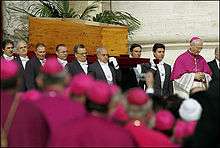
The part of the Mass of Requiem called the Liturgy of the Eucharist began. Cardinal Ratzinger and the concelebrating cardinals gathered around the altar to consecrate the bread and wine.
After the Eucharistic Prayer (the point in the Mass when it is believed the elements become Christ), the Lord's Prayer was sung followed later by the brief Latin litany, "Agnus Dei". The Eucharist was then taken to the congregation in St. Peter's Square to be distributed among those present. As the congregation received the Blessed Sacrament, Psalm 129 (in some Biblical versions Psalm 130) was sung. Its lyrics proclaimed, "Out of the depths I cry to you, O Lord; Lord, hear my voice."
After the Liturgy of the Eucharist, the crowds in the streets of Vatican City burst into applause, waving flags and banners chanting, "Santo Subito!" which means "Saint now!" and "Giovanni Paolo Santo" or "Saint John Paul!". A few also repeatedly chanted "Magnus" or "Great", spontaneously declaring that he should be John Paul the Great.
Commendation

After the congregants received Communion, Cardinal Ratzinger led the Rite of Final Commendation and Farewell. He asked the College of Cardinals and patriarchs of the Eastern Rite to converge on the casket of Pope John Paul II. The congregants were called to prayer, "Dear brothers and sisters let us entrust to the most gentle mercy of God, the soul of our Pope John Paul II." He continued, "May the Blessed Virgin Mary... intercede with God so that He might show the face of His blessed Son to our Pope, and console the Church with the light of the Resurrection."
The choir sang the Litany of the Saints; the same litany was chanted during the procession that transferred the body of Pope John Paul II from the Clementine Hall of the Apostolic Palace to St. Peter's Basilica. Breaking with tradition for the sacred prayer, the names of the saints canonised by Pope John Paul II, such as Faustina Kowalska and Josemaría Escrivá, were allowed to be included in the litany. Names of saints included in the more traditional litany were also included along with the newer saints.
After the singing of the Litany of the Saints, the patriarchs, archbishops and metropolitans of the Eastern Catholic Churches approached the coffin of Pope John Paul II for their own rituals of commendation and farewell (panikhida). They incensed the casket and chanted the Easter proclamation, "Christ is risen from the dead, trampling down death by His death", three times, and the rest of the Eastern memorial service. The Eastern patriarchs together with the entire College of Cardinals witnessed the sprinkling of the casket with the waters used in the Sacrament of Baptism. Incense was used once again, when Cardinal Ratzinger, assisted by an Italian deacon of the Pontifical Major Seminary in Rome, father Nello Luongo, incensed and prayed for the dead Pope at the very end of the Mass. The Prayer of the Eastern Churches from the Parastas (Office of the Dead) of the Byzantine Rite was chanted in Greek and in Arabic by Melkite Greek Catholic Patriarch Gregory III Laham, ending with "Your memory is eternal, our brother, dignified with blessings and unforgettable."
The Mass of Requiem officially ended with the congregation standing to sing the In paradisum: "May Angels lead you into Paradise; upon your arrival, may the Martyrs receive you and lead you to the holy city of Jerusalem."
The Papal Gentlemen carried the Pope's coffin towards the entrance of St. Peter's for interment, and the congregation in attendance broke out into applause and cheered as a final farewell. The coffin was then turned 180 degrees to face the congregation and the cameras, and the crowd applauded and cheered with more fervour before it was taken out of the public view for the last time. Cardinal Ratzinger handed over authority of the Rite of Interment to Cardinal Martínez Somalo, the Camerlengo.
Rite of Interment
The people of Poland had wished for the heart of John Paul II to be removed from his body and transferred to Wawel Cathedral to be buried alongside the greatest of Poland's monarchs and National heroes. Cardinal Martínez Somalo said that the request would not be obliged, as per the dead Pope's wish not to have any parts of his body removed during preparation for the funeral.[16]
An underground grotto beside the former shrine of the now glass-entombed and preserved body of Pope John XXIII was chosen for the interment of John Paul II. He was lowered into a tomb that had been prepared following the transfer of John XXIII's remains from the grotto to the main floor of the basilica after his beatification. The vault that originally held John XXIII's body had been removed so a new tomb could be built. The College of Cardinals decided to keep John Paul II beneath the altar of St. Peter's Basilica, citing the possibility of future beatification and canonisation into sainthood.
Pallbearers took the coffin through the central door of St. Peter's Basilica. At that point a single bell tolled. The pallbearers took the coffin through the Santa Marta Door, under the Monument to Alexander VII, to the outside (South) of the Basilica. They entered the grottoes, a cemetery underneath the Basilica where Saint Peter is believed to be buried, through the door now used as the grottoes' exit. After passing beneath low ceilings and through long corridors, the pallbearers stopped at the crypt of Pope John Paul II.
_2.jpg)
Cardinal Martínez Somalo, Camerlengo of the Roman Church, then presided over the Rite of Interment. It was a private service witnessed only by the highest-ranking members of the College of Cardinals. As is custom, Pope John Paul II was entombed in three nested coffins. The cypress coffin was sealed and tied with three red silk ribbons.[17] The cypress casket was lowered into a larger solid zinc (traditionally lead) casket, which was soldered shut. This coffin was adorned with three bronze plaques: a simple cross at the head of the coffin, a middle plaque with the Pope's name and the length of his life and pontificate, and a third with Pope John Paul II's personal coat of arms at the foot. The zinc casket was finally lowered into a larger walnut (traditionally elm) casket, bearing three identical plaques, which was shut with nails of pure gold. The middle plaques bear the following statement in Latin:
| Latin | English translation |
|---|---|
ANNO DOMINI MMV |
Body of John Paul II, Supreme Pontiff |
The unified coffin was lowered into the ground, as the Pope requested, and covered with a plain stone slab featuring his name and dates of his pontificate. Pope John Paul II asked that his burial be like that of Pope Paul VI, not in an elaborate sarcophagus and ornate above-ground tomb, but in "bare earth". His remains lay in this tomb for six years before it was exhumed to prepare for his beatification in 2011.[18]
Cardinal Martínez Somalo ended the Rite of Interment with the words, "Lord, grant him eternal rest, and may perpetual light shine upon him." Those present sang "Salve Regina" or "Hail Holy Queen."
Dignitaries
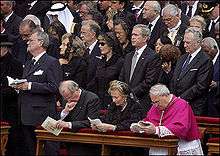
Before the College of Cardinals could offer official customary invitations to the various heads of state and government, over 200 foreign officials had expressed their desire to attend the Mass of Requiem. 18 international organizations and 112 countries attended the event. A total of 10 royalty guests and 70 heads of state and 15 former heads of state was present. Among the most familiar faces worldwide were the President of the United States and two former presidents of the United States, the Prime Minister of Italy, the current and former Presidents of Brazil, the President of Poland, the President of France, the President of Ireland, the Taoiseach of Ireland, the King and Queen of Spain, the King and Queen of the Belgians, the Prime Minister of the United Kingdom, the Chancellor of Germany and the President of Germany, the Prince of Wales (who postponed his wedding to Camilla Parker-Bowles by 24 hours, to attend), the Prime Minister of Canada, the King and Queen of Jordan, the President of Afghanistan, and the Vice-President of India. International representatives included the Secretary-General of the United Nations. Also attending were Mohammad Khatami of Iran and Israeli President Moshe Katsav. Kings and Queens from Denmark, Sweden and Norway were also present.
The dignitaries were seated alphabetically according to the French spelling of their country's name and arranged according to diplomatic protocol, with Sovereigns taking precedence over elected heads of state and seated in the front row. The largest delegations were the Italian (sitting in the first honorary seats were the President of Italy and other high Italian dignitaries) and Polish ones. As such, Israeli President Moshe Katsav sat only two seats away from the president of Iran amidst strained relations. Zimbabwean president Robert Mugabe defied a European Union travel ban to attend the funeral. Taiwanese President Chen Shui-bian made an unprecedented appearance and was seated in the front row as the head of state of China, due to the existence of diplomatic relations between the Holy See and the Republic of China. The People's Republic of China was not invited to the funeral and protested to Italy for allowing Chen passage to the Vatican. Altogether, the Mass of Requiem was deemed at the time to be the largest gathering of heads of state in world history, exceeding the gathering at the state funeral of Sir Winston Churchill in London in 1965 and the funeral of Josip Broz Tito in 1980. It was, however, surpassed by the State memorial service of former South African President Nelson Mandela in Johannesburg, South Africa on 10 December 2013 with 40 royal leaders, 180 heads of state and 70 former heads of state attended (See List of dignitaries at the memorial service of Nelson Mandela). Some of the dignitaries, including German Chancellor Gerhard Schroeder, King Juan Carlos and Queen Sofia of Spain[19] who attended the funeral also attended the installation Mass for Pope Benedict XVI on 24 April 2005.
Novemdiales
After the Rite of Interment, nine official days of mourning began. The devotional called novemdiales features a Mass of Requiem on each of the nine days at St. Peter's Basilica. Several cardinals were chosen by Cardinal Ratzinger to have the honour of presiding over each Mass. One of the most controversial honourees was Bernard Francis Law, Archpriest of the Basilica di Santa Maria Maggiore, scheduled to preside a novemdiales on 11 April. During his tenure as Archbishop of Boston, Cardinal Law was accused of having mishandled cases of sexual abuse at the hands of diocesan priests. The event sparked the nationwide Roman Catholic Church sex abuse scandal in the dioceses of the United States.[20]
Several members of the Survivors Network of those Abused by Priests (SNAP) flew to Rome to protest saying Cardinal Law's place of honour was painful to sexual abuse victims and embarrassing to Catholics. Just as the group's members arrived at St. Peter's Basilica, led by founder Barbara Blaine, police officers escorted them outside the confines of St. Peter's Square. Blaine was unable to pass out fliers to people walking into the Mass offered by Cardinal Law.[20]
Blaine had earlier told reporters in a press conference, "We are the sons and daughters of the Catholic family who were raped, sodomized and sexually molested by priests. At this time, we should be able to focus on the Holy Father's death, instead of Cardinal Law's prominence."[20] The College of Cardinals responded by stating that Cardinal Law was honoured as a matter of his being the ordinary of one of the most important basilicas of the Roman Catholic Church.
14 April novemdiales Mass at St. Peter's Basilica replaced traditional hymns and prayers with those of the Maronite Rite, one of the Eastern Catholic Churches. Cardinal Nasrallah Boutros Sfeir, Patriarch of Antioch of the Maronites, presided over the Mass. It was the first time a cardinal patriarch of an Eastern Catholic Church offered a novemdiales Mass, in his own rite, for a pope.
Security
The immensity of the pilgrim presence in Rome and the vast diplomatic contingent from nations around the world raised concerns by the College of Cardinals that the funeral, conclave and installation of a new pope would make Vatican City a target for terrorism. The anti-terrorism task forces responsible for securing the funeral considered international terrorists the primary potential threat because of the attending dignitaries; domestic terrorism from Italian political extremists was considered less likely.
On 6 April—in advent of the arrival of the United States delegation aboard Air Force One, protected by a military escort—the Italian government issued a no-fly zone within a five-mile radius of Rome. The Italian government considered the President of the United States, the first sitting American president to attend a papal funeral, as the most tempting target for terrorists. Official diplomatic delegations from other nations began arriving at the same time.
The Aeronautica Militare Italiana (Italian air force) prepared their aircraft to be launched at a moment's notice in case of a terrorist strike. The Italian Army deployed anti-aircraft missiles around Vatican City, to the grudging dismay of the College of Cardinals. Marina Militare (Italian navy) warships were positioned along the shorelines of Italy armed with torpedoes. Gunboats ran up and down the rivers and waterways of Rome, including the Tiber River which flows around Vatican City. One thousand sharpshooters were positioned on strategic rooftops throughout the Italian capital as Carabinieri police task forces swept aqueducts and drains for explosives. Helicopters were dispatched to scan the city streets from above. Plans to close Ciampino Airport from commercial flights and divert air traffic to and from Leonardo da Vinci International Airport in Fiumicino were finalised for the day of the Mass of Requiem and Interment of Pope John Paul II. Other smaller civilian commuter and recreational airports were also shut down.
Some of the same security measures that were in effect for the funeral were also in effect for the installation Mass of Pope Benedict XVI on 24 April.
Notes
- "CNN Transcript from 4 April 2005". Retrieved 4 March 2008.
- "Universi Dominici gregis". Archived from the original on 6 May 2007. Retrieved 4 March 2008.
- "The Ultimate Photo Shoot". Retrieved 9 August 2010.
- "CNN.com: "Pope John Paul II buried in Vatican crypt-Millions around the world watch funeral"". CNN.com. Archived from the original on 16 March 2008. Retrieved 19 October 2008.
- "The Independent: "Millions mourn Pope at history's largest funeral"". London: Independent News and Media Limited. 8 April 2005. Retrieved 19 October 2008.
- Holmes, Stephanie (9 April 2005). "City of Rome celebrates 'miracle'". BBC News. Retrieved 4 March 2008.
- ""Pope John Paul II Funeral"". Outside the Beltway. Retrieved 20 October 2008.
- "American Morning report, April 8, 2005". International Wire. 8 April 2005. Retrieved 4 March 2008.
- "Europe | Pontiff's seal and ring destroyed". BBC News. 16 April 2005. Retrieved 5 May 2009.
- "Eucharistic Concelebration for the Repose of the Soul of Pope John Paul II: Homily of Card. Angelo Sodano". The Holy See. 3 April 2005. Archived from the original on 25 December 2008. Retrieved 10 February 2020.
- Regina Caeli, 3 April 2005
- "Chicago Tribune". Archived from the original on 1 December 2008. Retrieved 4 March 2008.
- "BBC 8 April 2005". BBC News. 8 April 2005. Retrieved 4 March 2008.
- "Funeral mass of the Roman Pontiff John Paul II: Homily of His Eminence Card. Joseph Ratzinger". Holy See. 8 April 2005. Retrieved 30 July 2012.
- Wakin, Daniel J. (12 April 2005). "Cardinals Lobby for Swift Sainthood for John Paul II". The New York Times. Retrieved 3 May 2010.
- Tomov, Nikola. "Preserving the Pontiff: an Account of the Body Preservation Methods Used by the Roman Catholic Church" (PDF). Acta Morphologica et Anthropologica. 25 (1–2): 117–121.
- "World | Europe | Pope buried in St Peter's crypt". BBC News. 8 April 2005. Retrieved 5 May 2009.
- Willey, David (13 April 2005). "World | Europe | Venerable resting place for the Pope". BBC News. Retrieved 5 May 2009.
- "Mass Held to Install Pope Benedict XVI". The Washington Post. Retrieved 25 October 2017.
- "BBC: Victims protest against Rome Mass". BBC News. 11 April 2005. Retrieved 4 March 2008.
References
- Daily Bulletin of the Holy See Press Office – No. 0184
- The Apostolic Constitution of John Paul II, Supreme Pontiff, Universi Dominici gregis: on the vacancy of the Apostolic See and the election of the Roman Pontiff
- Archived films of events during the Vacant See (including the funeral) (Vatican TV)
- Venerable resting place for the Pope
- John Paul buried in St Peter's crypt on 8 April 2005 at 2:30pm
- Link to official funeral rites programme from the Vatican in PDF format, including portions of the liturgies not witnessed by the public. Text mainly in Latin and Italian, including other languages heard in the service
- Text of eulogy buried with Pope John Paul II (Latin)
- Text of eulogy buried with Pope John Paul II (English translation)
External links
| Wikinews has related news: |

